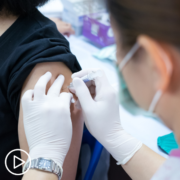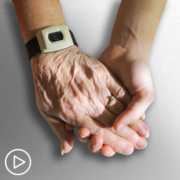See More From INSIST! AML
Related Resources:
Transcript:
Katherine:
Hello, and welcome. I’m Katherine Banwell, your host for today’s program. Today we’re going to discuss how to access the most personalized AML therapy for your individual disease, and why it’s essential to insist on key testing. Before we meet our guest, let’s review a few important details. The reminder email you received about this program, contains a link to program materials. If you haven’t already, click that link to access information to follow along during this webinar.
Finally, please remember that this program is not a substitute for seeking medical advice. Please refer to your healthcare team about what might be best for you. All right, let’s meet our guest today. Joining me is Dr. Ellen Ritchie. Dr. Ritchie, would you please introduce yourself?
Dr. Ritchie:
Hello, my name is Dr. Ellen Ritchie, and I am an attending with a Leukemia service, and an assistant director since, for the last 15 years.
And I treat mainly Acute Myeloid Leukemia, Myelodysplastic syndromes, which are kind of a pre-Leukemia; and Myeloproliferative diseases. And have a particular interest in the treatment of older patients with AML.
Katherine:
Excellent, well thank you so much for joining us today. As we begin to talk about personalized therapy and AML, let’s start with the basics. How would you define personalized medicine?
Dr. Ritchie:
Personalized medicine, to me is really, it’s a difficult question. It’s trying to find the best treatment for a particular patient. And it’s looking at biologic issues, what kind of cancer, what type of AML is it, what are the specific mutations or chromosomal abnormalities. But it’s also looking at the person. Is the patient active or not active? Do they have lots of other diseases like diabetes and coronary artery disease? Or pulmonary disease, or are they completely healthy?
Or, do they have support at home? If they’re sick at home is there someone who can take care of them, versus a situation where you’re older and alone and you have no real family member to rely on. So, all of these things are very important in making a personalized decision as to how you treat a patient.
Katherine:
Well, it sounds like, each person’s AML is unique. So, let’s help our audience be clear about basic testing. What tests are necessary to help understand a patient’s specific disease at diagnosis?
Dr. Ritchie:
I mean certainly it’s important to do a physical exam and to find out what the general health of the patient is. In order to evaluate an AML, or any other Leukemia, I look at the peripheral blood smear. To look at what I think the type of Leukemia might be that I am dealing with. There are some Leukemias that have particular way that they look like Acute Promyelocytic Leukemia for which there is a designated therapy which works.
And you can tell that just by looking at a peripheral blood slide. The next test is always a bone marrow biopsy. Patients are not delighted that that is a test, but it is a test that can be done in the office, usually within 15 to 20 minutes. And that test gives us a lot of information. It gives us information about what type of AML it is, what are the markers on the outside of the cell, it gives us information about the chromosomes inside the Leukemia cell. Are there missing chromosomes, or rearranged chromosomes? And if there are, that can be very relevant to the prognosis. And lastly, it’s sent for a particular mutations or markers. So, we look for IDH3 mutations, we look for FLT3 mutations, we look for IDH1 and IDH2 mutations, and we do an entire myeloid panel. Which is about 44/45 genes that are most commonly mutated in patients with AML.
So that’s the initial work up for any AML patient.
Katherine:
You mentioned markers Dr. Ritchie. What is genomic, or bio marker testing?
Dr. Ritchie:
So, we’re looking really at most specifically at mutations inside individual genes that might be in your Leukemia cell. So, there are some mutations actually that confer a better prognosis. Like NPM1 or CEPBA, those can be more positive type of prognosis than some of the others.
But we’re also looking for markers that might be targetable with certain therapies that we have. So, if you have a FLT3 ITD or TKD, we actually have particular drugs which can target those particular mutations. There are also drugs that are FDA approved to treat IDH1 and IDH2 mutations.
There are certain mutations that have a relatively poor prognosis, like TP53 for which there are clinical trials which are available, which specifically are meant to target patients who have those sorts of mutations. And there’re other clinical trials using the FDA approved drugs that I just mentioned, for FLT3, for IDH1 and IDH2 and combining it with other agents to try and improve outcome in AML patients.
Katherine:
Some patients may not know if they’ve received these important tests, so what key questions should they be asking their physician about testing?
Dr. Ritchie:
So, physicians, they – financial coverage of the mutational testing is not uniform across the country and across insurances. So, Medicare and different Medicare insurances and some of the private insurances all vary in their coverage.
So, in my clinic, I am asking – I prefer the test that we do in house at Cornell. But it’s important that I ask, what will their insurance cover. And make sure that I send the appropriate testing that will be covered by insurance. There are some insurances that will not cover this type of testing. So, it is a real question for the patient, when you go to see the doctor to say, are you going to do mutational NGS testing?
And, will my insurance cover this? Hopefully most – if Medicare adopts the coverage of these types of mutational testing, it’s often true that private insurance will eventually pick this up. But it’s a murky field and it’s really important to talk to your doctor about this. The cost of the bone marrow biopsy, and the chromosomal evaluation is nearly always covered by insurance.
Katherine:
Okay, that’s really great advice, thank you. How do the results of these tests affect prognosis and treatment?
Dr. Ritchie:
Well, when a patient has AML, if they are a fit patient, if it will help us determine after initial induction, whether to cure the patient we need to do a bone marrow transplant, or we can just continue with chemotherapy.
And those are really important things to determine. So, if you have a good prognosis AML, if you have an AML that has certain translocations like inversion 16 or 821, or if you have a CEPBA mutation or you have an NPM1 mutation, and that’s all you have, you may do particularly well with chemotherapy treatment alone. And you won’t need to have a bone marrow transplant.
If you have certain other mutations, we know that the only way that we’re going to cure you, is with a bone marrow transplant. And if you are fit, when we finish induction and even as we’re doing induction, we’re preparing you for a bone marrow transplant down the line.
One disadvantage, just to mention about the molecular testing, is it doesn’t come back as quickly as some of the other testing. So that you will have already started induction chemotherapy most generally before the mutational testing comes back. Which can be anywhere – depending upon the institution, between seven and 21 days. So, it takes time for those results to be available.
Katherine:
Outside of test results Dr. Ritchie, what other factors should be considered when choosing treatment?
Dr. Ritchie:
So, you want to choose whether a patient is most likely to benefit from intense induction chemotherapy. With strong chemotherapies where the backbone of those therapies would be an anthracycline, like Daunorubicin or Cytarabine, or Daunorubicin or Idarubicin, together with Cytarabine. And these are intensive chemotherapies. Versus, non-intensive chemotherapy which is able to be done as an outpatient, more frequently. And it is something that is gentler for a patient, they’re less likely to have severe toxicity. And the backbone of those regimens is using a drug called Azacitidine or Decitabine, together with a second drug called Venetoclax.
So, these are the two backbones, there may be clinical trials or there may be targetable aspects of your Leukemia, which drugs would be added to either of those backbones. But those are the two backbones. And I also like to identify those patients that may not benefit from chemotherapy at all. And so, it’s very important, I think to really get to know your patient. And I spend time with my patient, particularly on the first visit, to understand not only their physical health, but their mental health. How good is their cognition, what is their mood, are they depressed, or are they happy people? And what is their circumstance? Do they have people to support them? Do they live close to family? Is a caregiver able to come, with an elderly patient for example, to visits?
Those, and whether or not they’re living alone and need tremendous support. So that’s really important to determine and helps me to choose what the best therapy might be. And also, concurrently what I can do to shore up the patient to do better with whatever therapy that I’m giving them. I.E., if you’re depressed, let’s work on that, or if your blood pressure is too high, or if you are – your diabetes is out of control at the same time that I’m seeing you, to try and fix those particular problems. In older patients I often do sort of a miniature version of the geriatric assessment. And in trials that have been so far, the most important aspects of the geriatric assessment, are really what is your cognitive function? Do have a mild dementia or do you not have a mild dementia? Because dementia may be or mild dementia may be associated with poorer outcome.
The other is, are you able to do what we call the incidental tasks of daily life. So, you know fundamental tasks are really brushing your teeth and combing your hair, and dressing yourself. But are you able to do your cooking and your shopping and your banking and those things? Patients who have trouble doing their cooking and shopping and banking, and those types of activities, that also has been associated with a poor overall survival in AML. So, it’s really important to determine all of those aspects and if there are any deficiencies, to really know that the only therapeutic choice for that particular patient would be a low-intensity therapy.
Katherine:
You touched upon this earlier, but what targeted therapies or treatments are available for AML patients?
Dr. Ritchie:
So, there have been many recent FDA approvals of drugs that are targeted. One, is the FLT3 inhibitors. And the two that are available are Midostaurin, which is most commonly – was the first drug that was really added to intensive chemotherapy.
And clinical trials show that in those FLT3 positive population that patients had an overall better outcome if Midostaurin were added to intensive chemotherapy. There’s also a drug called gilteritinib, and this drug is also a FLT3 inhibitor that was tested in patients who had refractory leukemia. They could either get real chemotherapy regimen or they could get gilteritinib. And it turns out in the FLT3-positive patients, the gilteritinib was superior to the strong chemotherapy. So that’s been approved for patients who have refractory, or disease that didn’t really respond to initial therapy, that is IDH – or is FLT3 positive.
Then there’s the IDH1 and IDH2 inhibitors that have also been approved, and a small proportion of AML patients will be positive for IDH1 or IDH2 mutations.
The IDH1 inhibitor Ivosidenib, is available and can be used to treat patients if you know up front, they have an IDH1 inhibitor. So, that’s a regimen where the single agent can be used to treat an IDH1 mutated patient who’s newly diagnosed. Those patients are also eligible for many clinical trials now, where they’re combining that particular drug with other agents, in an effort to improve outcome. For IDH2 positive patients, there’s a drug called Enasidenib. And this drug is used mainly in patients in the second line setting. But it specifically targets IDH2. And patients go into remission sometimes for a prolonged period of time. So, these drugs are FDA approved, and they’re treating targetable mutations.
TP53 mutations are a particularly bothersome mutation because it confers a poor outcome. And I’m happy to say that we have clinical trials now that are available that actually target TP53 mutations.
So, there are – there is therapy available for that type of mutation that was not available before through the clinical trials. And I expect in coming years that we’re gonna see more and more targeted therapies develop in AML which can be used potentially in combination with what we’re already using as backbones to enhance the outcome of patients with this disease.
Katherine:
Well, how do targeted therapies work?
Dr. Ritchie:
So, targeted therapies work on – it’s sort of complicated. The targets which are available, IDH or the FLT3 is really on the outside of the cell and it is a drug which is targeted directly to the FLT3 on the outside of the cell.
It works quite well in the peripheral blood, where you see the blast oftentimes disappear. The big concern always is how well it’s working getting deep into the marrow. But it’s looking at the target on the outside of the cell. IDH1 and IDH2 inhibitors work on particular chemicals which are involved in the kreb cycle, and those of you that took high school chemistry may have memories buried in the deep parts of your brain of learning the kreb cycle. And this is a fundamental metabolic cycle inside cells, and if you have a mutation, an IDH1 or IDH2, you’re unable to go through that full kreb cycle in the appropriate way. And that is something that leads to you having a cancer, in this case AML. So, these drugs actually interfere with what’s happening in that kreb cycle, and allow you to make more normal cells.
Katherine:
You mentioned earlier Dr. Ritchie, low-intensity therapy. Could you tell us about the types of treatment options?
Dr. Ritchie:
So, I’ll go – high-intensity therapy or intense chemotherapy always has to be given really in a hospital. And if you don’t start it – if you can start certain intensive chemotherapies, like Vyxeos, which is also intensive, in the outpatient setting, but by day seven or eight, you end up in the hospital. And in intensive chemotherapies, you lose your hair, there’s GI toxicities, you’re at high risk of developing infections and you need a lot of transfusion. And for even young people, it’s a difficult therapy for which you’re in the hospital, and 90-some percent of patients are on IV antibiotics.
So, it’s intensive chemotherapy because it has to be given in a hospital setting and requires intensive supportive care. Low-intensity therapy can be given in the outpatient setting. So, at the present time you can get a drug like Azacitidine, for example, which is an injection that you get seven days in a row. Unfortunately, you have to come to the doctor’s office every day for those injections, but once you’ve had the injection, you can go home. Combined with Venetoclax which is an oral agent. So, an oral agent can be given at home. You need close supervision in the physician’s office when you’re on this type of therapy, but you don’t need the constant support that you need if you are getting intensive chemotherapy. So, it can be done, in the comfort really of your home and with your family. You will have to come in and have transfusions potentially as an outpatient, nearly everyone does. And there’s always the risk that you develop a fever and if you do, you have to come into the hospital for IV antibiotics.
But in general, low-intensity means not so much support needed in a hospitalized setting, and the tolerability of this particular chemotherapy in the outpatient setting.
Katherine:
Once a patient has begun treatment, how do you monitor whether it’s working?
Dr. Ritchie:
So, one of the more frustrating things about being an AML patient, is you don’t know right off the bat whether or not that you have gone into remission. So, what happens is you receive the chemotherapy, and the day you start chemotherapy is really day one. And somewhere around day 14, you’re at your lowest point. So, your blood counts are low, and you often feel really terrible, and you really wonder, is this working? But unfortunately, I can’t really tell you. Some institutions do bone marrow biopsies if you have intensive chemotherapy on day 14, or if you’re getting Venetoclax therapy somewhere around day 21 to look and see whether they still see Leukemia cells, but the utility of that is different per institution.
The real test of whether chemotherapy x`, is at the end of about 28-35 days, are your blood counts coming up, and are you making normal blood cells. Are you making platelets, which are the part of the blood that clots the blood? Or are you making neutrophils, which are the important cells needed to help you fight infection. So, the real proof of a remission, is are your platelets over 100,000? Is your neutrophil count over 1,000? And when we look in the bone marrow around that time, do we see normal cells developing and no Leukemia?
Katherine:
How often should testing take place? And should patients be retested over time?
Dr. Ritchie:
So, the bone marrow biopsy is done frequently once you have a diagnosis of Acute Leukemia. So certainly, it’s done upon diagnosis of the disease.
And as I mentioned earlier in certain institutions, about halfway through your chemotherapy cycle, they’ll do a bone marrow biopsy to see whether or not they see any residual Leukemia cells. That’s not done everywhere, and it’s done differently depending upon institutions sometimes. At the end of the chemotherapy treatment, if you recover your blood counts, we do a bone marrow biopsy to confirm a remission. If by day 35, we haven’t seen that your blood counts are recovering, we may do a bone marrow biopsy to see whether or not we see Leukemia cells in there, or early recovery. So, you’re definitely going to have bone marrows at those time points. If you’ve gone into remission, it depends on what we’d do next as to when you would have another bone marrow biopsy. So, if you’re going to bone marrow transplant you may have one more biopsy, just prior to going into transplant, and another biopsy at the end of the first month after transplant.
If you’re gonna have what we call ongoing therapy, roughly every three or four months, we may do a bone marrow biopsy to determine whether or not the remission is holding. If during ongoing therapy, we see that there is blood count abnormalities that we weren’t expecting, that might be a reason that we would do a bone marrow biopsy. And that’s unpredictable as to when that would be.
Katherine:
Dr. Ritchie, what advice do you have for patients to help them feel more confident in speaking up and advocating, being a partner in their care?
Dr. Ritchie:
Well, when you choose a Leukemia doctor, you need to choose someone that you can actually communicate with. Someone who you feel is not allowing you to ask questions, or is not curious about what your life is like, you may wanna think, I wanna check out somebody else.
Because it’s really important you like the person who’s your doctor, and that you have a trust relationship together. So, it’s really – I tell some patients it’s a marriage of convenience that we have. And that you really have to think of it that way. If someone doesn’t allow you to ask questions or if they are not fully answering your questions in a way that you understand, try and speak up for yourself and make sure that the doctor tries to address that. And if the doctor won’t address those things for you, or you feel like you don’t understand what is being explained to you, then you can think about trying to see someone else. I think it’s really important if you can, to write down as many questions as you have about your disease before you come in.
Because often what happens is you get there, you’re stunned by the amount of information, and the questions you wanted to ask, you forget. And the next day, you’re like, ugh, I didn’t ask these questions. So, before you come in, if you write questions. Questions about insurance coverage, that may not be something that we go over. Or questions about toxicities, or questions, if I’m gonna lose my hair, do you have the name of a wig facility. All these questions that you might have, put them on a piece of paper, so that they can be addressed when you’re with the doctor. And other things will come up, you’ll have other questions when you’re there, but make sure your fundamental questions are answered.
Katherine:
Yeah, those are great suggestions. We have a couple of audience questions. Mike wants to know, what does it mean to have high-risk AML?
Dr. Ritchie:
High-risk AML means that there is something in your chromosomes that are worrisome and may confer a worse outcome. Or that one of the mutations that you have, or the combination of mutations that you have and the genetic testing are poor risk mutations that are associated with poor outcome. So, high-risk, really means a high risk of progression, or a high risk of – it’s a high risk of not going into remission and not being treatable AML. So, these are AMLs we treat aggressively, and if we get a patient into remission, we generally send high-risk patients to a bone marrow transplant.
Katherine:
The second question is from Craig, he says; I’m currently undergoing treatment for AML, is the Covid-19 vaccine safe and effective?
Dr. Ritchie:
I recommend the Covid-19 vaccine to everyone, all my patients. A little immunity is better than none. And there is preliminary data, looking at patients with Myeloid malignancies, not Lymphoid, but Myeloid malignancies, where it appears there is an immune response to the Covid-19 vaccine. So, I would suggest that you get the Covid-19 vaccine. Any of them that are available, are good. Whether it’s Moderna, or Pfizer, or Johnson and Johnson. Whatever is available to you, you should go ahead and get.
Katherine:
Are there any symptoms or issues that AML patients should be looking for post-vaccine?
Dr. Ritchie:
Post-vaccine, there’s a lot of symptoms that people have. And they can be similar among Myeloid patients. Some of my patients have had no reaction whatsoever, some people have had a really sore arm.
Some patients are incredibly tired after the vaccine; some patients develop a low-grade fever for a couple of days. Those are really what we watch for. Sometimes when there’s a reaction, we’re hopeful that there’s an antibody being made, or an immune response that’s developing. So, it’s not always a bad thing if you have a reaction. But I don’t think that the reactions of patients of Myeloid malignancies is any different than that of the general public.
Katherine:
That’s what it sounds like. To close Dr. Ritchie, what would you like to leave the audience with? Are you hopeful about the future of AML treatment?
Dr. Ritchie:
I’m very hopeful. I’ve worked in this field for 15 years and through the 15 years we have seen a lot of new drugs that have been approved for AML. It’s remarkable, the FLT3 inhibitors, IDH1 and IDH2 inhibitors, new formulations of intensive chemotherapy, like Vyxeos, the Pfizer drug; glasdegib – I can never say that one. And most importantly, venetoclax, which has really revolutionized our treatment of low-risk, or not low-risk, but the low intensity patient.
I see in the future that there is gonna be more – there’s an emphasis on immunotherapy, so I think we’re gonna see more antibody-based therapy that’s going to be approved by the FDA. Maybe it will be used in combination with the drugs that we are already using. There are all sorts of combinations using all the FDA approved drugs in different ways together. So, we can maybe do better with the drugs that we have. And there’s always new targeted drugs which are being tested in AML. So, I think as time goes on, from a molecular perspective it will be even more targeted. And I’m hoping also that there will be oral formulations of a lot of our drugs. So, it’s kind of exciting that there’s an oral form of Decitabine called Inqovi, which is something that could potentially be given in induction therapy right off the bat with Venetoclax for an all-oral regimen at home.
All of these things are great advances, in my opinion, and I think that the opportunity to treat patients outside the hospital, with more targeted therapy and immunotherapy is gonna be the future.
Katherine:
Yeah. And the future sounds promising. Thank you so much for joining us today Dr. Ritchie.
Dr. Ritchie:
Thank you for having me.
Katherine:
And thank you to all of our partners.
To learn more about AML, and to access tools to help you become a proactive patient, visit powerfulpatients.org. I’m Katherine Banwell, thanks for joining us.






















